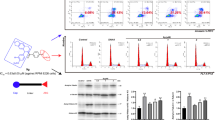Abstract
A series of 1,3,5-triazine-based hydroximic acids 6a–6i were designed and synthesized, and they were found to be potent inhibitors of human histone deacetylases. These compounds were evaluated for their antiproliferative activity by MTT assay, and most of them exhibited significant antiproliferative effect on HCT-116, MCF-7, and HeLa cancer cell lines. DNA flow cytometric analysis revealed that compound 6i induced apoptosis and cell cycle arrest at G2/M phase in HCT-116 cells.




Similar content being viewed by others
References
Arrowsmith CH, Bountra C, Fish PV, Lee K, Schapira M (2012) Epigenetic protein families: a new frontier for drug discovery. Nat Rev Drug Discov 11:384–400
Bolden JE, Peart MJ, Johnstone RW (2006) Anticancer activities of histone deacetylase inhibitors. Nat Rev Drug Discov 5:769–784
Cai X, Zhai HX, Wang J, Forrester J, Qu H, Yin L, Lai CJ, Bao R, Qian CG (2010) Discovery of 7-(4-(3-ethynylphenylamino)-7-methoxyquinazolin-6-yloxy)-N-hydroxyheptanamide (CUDC-101) as a potent multi-acting HDAC, EGFR, and HER2 inhibitor for the treatment of cancer. J Med Chem 53:2000–2009
Chen LQ, Petrelli R, Gao GY, Wilson DJ, McLean GT, Jayaram HN, Sham YY, Pankiewicz KW (2010) Dual inhibitors of inosine monophosphate dehydrogenase and histone deacetylase based on a cinnamic hydroxamic acid core structure. Bioorg Med Chem 18:5950–5964
Ciraolo E, Morello F, Hirsch E (2011) Present and future of PI3K pathway inhibition in cancer: perspectives and limitations. Curr Med Chem 18:2674–2685
Erlich RB, Kherrouche Z, Rickwood D, Endo-Munoz L, Cameron S, Dahler A, Rethinam MH, de Long LM, Wooley K, Guminski A, Saunders NA (2012) Preclinical evaluation of dual PI3K-mTOR inhibitors and histone deacetylase inhibitors in head and neck squamous cell carcinoma. Br J Cancer 106:107–115
Gao N, Rahmani M, Shi X, Dent P, Grant S (2006) Synergistic antileukemic interactions between 2-medroxyestradiol (2-ME) and histone deacetylase inhibitors involve Akt down-regulation and oxidative stress. Blood 107:241–249
Giannini G, Marzi M, Pezzi R, Brunetti T, Battistuzzi G, Marzo MD, Cabri W, Vesci L, Pisano C (2009) N-Hydroxy-(4-oxime)-cinnamide: a versatile scaffold for the synthesis of novel histone deacetilase (HDAC) inhibitors. Bioorg Med Chem Lett 19:2346–2349
Grant C, Rahman F, Piekarz R, Peer C, Frye R, Robey RW, Gardner ER, Figg WD, Bates SE (2010) Romidepsin: a new therapy for cutaneous T-cell lymphoma and a potential therapy for solid tumors. Expert Rev Anticancer Ther 11:997–1008
Lehrmann H, Pritchard LL, Harel-Bellan A (2002) Histone acetyltransferases and deacetylases in the control of cell proliferation and differentiation. Adv Cancer Res 86:41–65
Mann BS, Johnson JR, Cohen MH, Justice R, Pazdur R (2007) FDA approval summary: vorinostat for treatment of advanced primary cutaneous T-cell lymphoma. Oncologist 12:1247–1252
Qian C, Lai CJ, Bao R, Wang DG, Wang J, Xu GX, Atoyan R, Qu H, Yin L, Samson M, Zifcak B, Ma AW, DellaRocca S, Borek M, Zhai HX, Cai X, Voi M (2012) Cancer network disruption by a single molecule inhibitor targeting both histone deacetylase activity and phosphatidylinositol 3-kinase signaling. Clin Cancer Res 18:4104–4113
Rahmani M, Yu C, Dai Y, Ahmed W, Dent P, Grant S (2003) Coadministration of the heat shock protein 90 antagonist 17-allylamino-17-demethoxygeldanamycin with suberoylanilide hydroxamic acid or sodium butyrate synergistically induces apoptosis in human leukemia cells. Cancer Res 63:8420–8427
Rahmani M, Reese E, Dai Y, Bauer C, Payne SG, Dent P, Spiegel S, Grant S (2005) Coadministration of histone deacetylase inhibitors and perifosine synergistically induces apoptosis in human leukemia cells through AKT and ERK1/2 inactivation and the generation of ceramide and reactive oxygen species. Cancer Res 65:2422–2432
Venkatesan AM, Dehnhardt CM, Santos ED, Chen ZC, Santos OD, Ayral-Kaloustian S, Khafizova G, Brooijmans N, Mallon R, Hollander I, Feldberg L, Lucas J, Yu K, Gibbons J, Abraham RT, Chaudhary I, Mansour TS (2010) Bis(morpholino-1,3,5-triazine) derivatives: potent adenosine 50-triphosphate competitive phosphatidylinositol-3-kinase/mammalian target of rapamycin inhibitors: discovery of compound 26 (PKI-587), a highly efficacious dual inhibitor. J Med Chem 53:2636–2645
Zhang L, Fang H, Xu WF (2010) Strategies in developing promising histone deacetylase inhibitors. Med Res Rev 30:585–602
Zhang X, Zhang J, Tong LJ, Luo Y, Su MB, Zang Y, Li J, Lu W, Chen Y (2013) The discovery of colchicine-SAHA hybrids as a new class of antitumor agents. Bioorg Med Chem 21:3240–3244
Zuo M, Zheng YW, Lu SM, Li Y, Zhang SQ (2012) Synthesis and biological evaluation of N-aryl salicylamides with a hydroxamic acid moiety at 5-position as novel HDAC-EGFR dual inhibitors. Bioorg Med Chem 20:4405–4412
Acknowledgments
These studies in the laboratories were supported by the natural science foundation of Jiangsu Province (BK2011390), Priority Academic Program Development of Jiangsu Higher Education Instititutions (PAPD).
Author information
Authors and Affiliations
Corresponding author
Rights and permissions
About this article
Cite this article
Zhao, X., Tan, Q., Zhang, Z. et al. 1,3,5-Triazine inhibitors of histone deacetylases: synthesis and biological activity. Med Chem Res 23, 5188–5196 (2014). https://doi.org/10.1007/s00044-014-1084-z
Received:
Accepted:
Published:
Issue Date:
DOI: https://doi.org/10.1007/s00044-014-1084-z




